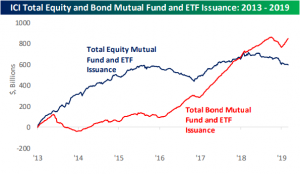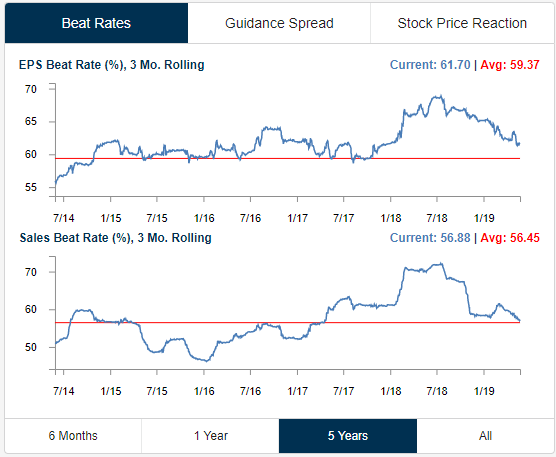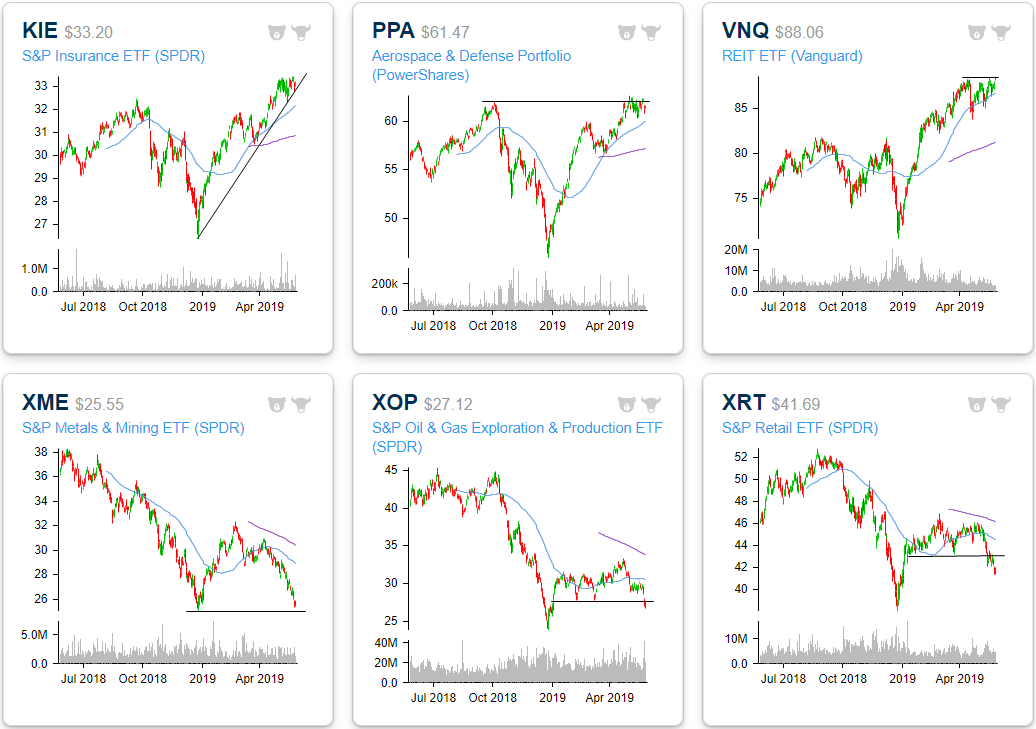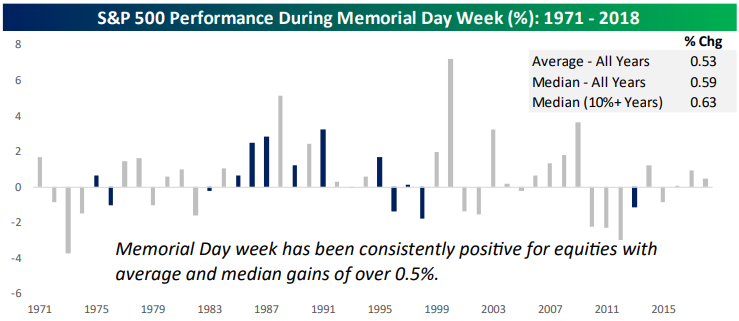Chart of the Day – Rebalancing?
If there was ever a time to “sell in May,” it was this year. Heading into today, the S&P 500 was already down over 4% on the month with three trading days left to go, and with today’s early weakness, we’re now on pace for a 5% decline for the month. Treasuries, meanwhile, have been surging. According to the BofA/Merrill Lynch index of long-term notes (10+ year maturities), US Treasuries were up over 4% MTD heading into the last three trading days of the month. While a 4% monthly decline for equities isn’t that rare (40 prior occurrences since 1990), when it’s accompanied by a rally in US Treasuries of the magnitude we have seen this month, it’s a lot less common. Since 1990, there have only been ten other months where the S&P 500 was down more than 4% heading into the final three trading days of the month while at the same time long-term US Treasuries were up over 4%.
In the table below, we have highlighted each of those ten prior periods along with how the S&P 500 has performed over the final three trading days of the month. The results are quite dramatic, suggesting we could be in store for a big move to close out the month of May.
Continue reading this Chart of the Day by logging in (if you’re already a member) or starting a two-week free trial to any of our research membership levels.
Global Equity Markets Oversold
As shown in our Trend Analyzer snapshot below of regional equity ETFs, all but two are trading in oversold territory, and all are solidly below their 50-day moving averages. But while US index ETFs have gotten more oversold over the last week (as indicated by the long tails to the right of each dot), we’ve actually seen some of the most oversold regional ETFs move higher within their trading ranges over the last week. The three emerging markets ETFs — IEMG, EEM, VWO — along with the MSCI All Country Asia ex Japan (AAXJ) were much more oversold last week at this time than they are now. At least it’s a start! Start a 2-week free trial to Bespoke Institutional for full access to our research and interactive tools.
US Equity Indices Now Solidly Oversold
As shown in our Trend Analyzer snapshot below, all six of the most closely watched US equity index ETFs are now trading in oversold territory. The dot in the “trading range” section of the snapshot shows where each ETF is currently trading within its range relative to its 50-day moving average. A move into the green shading of the chart represents oversold territory, which is more than one standard deviation below the ETF’s 50-day moving average. The dark green shading represents extreme oversold territory, which is between two and three standard deviations below the 50-DMA. The Russell 2,000 (IWM) small-cap ETF is the most oversold, while the remaining five are all in roughly the same position just above extreme territory.
Our Chart Scanner tool allows you to dive deeper into each ETF after getting an overhead view with our Trend Analyzer. The blue line in each chart represents each ETF’s 50-day moving average, while the purple line represents its 200-day moving average. You can also customize your settings to change the display of the moving averages and their colors. The Russell 2,000 (IWM) is at this point the only one that has traded below its 200-DMA, but the Dow (DIA) is the next closest to testing this key long-term support level. All of the six have rolled over from recent highs and have damaged whatever uptrends were in place. The negative technical set-up will continue until the 50-DMAs are re-taken once again. Start a 2-week free trial to Bespoke Institutional for full access to our research and interactive tools.
Morning Lineup – China on the Offensive
US futures have been weakening all morning continuing a trend that has for the most part been in place all night. Besides the usual back and forth rhetoric between the US and China over trade (this time China threatening to limit exports of rare earth metals to the US), weak data out of Europe, falling Treasury yields, and cratering oil prices aren’t helping sentiment as we head into the opening bell.
Make sure to check out today’s Morning Lineup for a recap of overnight earnings news, weak confidence data out of South Korea, the surge in German jobless claims, and other market-moving economic data out of Europe.
Yesterday marked the first time this year that the S&P 500 was up over 0.5% at some point intraday and then sold off to finish the day down by over 0.75%. This is notable for two reasons. First, it just goes to show how strong the equity market has been so far this year. For nearly the first five full months of the year intraday sell-offs of any discernible magnitude had been nearly non-existent during normal trading hours. Just as important, it suggests that the corrective phase the market has been in since early 2018 remains alive and well.
The chart below shows the S&P 500’s performance over the last five years and in it we have included red dots to show every day during this period that the S&P 500 was up 0.5% at some point intraday only to give it all back and more, finishing the day down at least 0.75%. All of the days fitting these criteria have been clustered into two periods. Of the now 19 occurrences since the start of 2014, the first ten were all clustered around a 15 month period spanning December 2014 through February 2016. Then from March 2016 right up through the last day of February 2018 there wasn’t a single occurrence. Since that drought ended, though, we’ve now seen nine occurrences over a similar 15-month span.

Start a two-week free trial to Bespoke Premium to see today’s full Morning Lineup report. You’ll receive it in your inbox each morning an hour before the open to get your trading day started.
The Closer – Put-Call Not Peaked, Bonds Overbought, Home Prices Picking Up – 5/28/19
Log-in here if you’re a member with access to the Closer.
Looking for deeper insight on markets? In tonight’s Closer sent to Bespoke Institutional clients, we begin with a look at what the put-call ratio is signaling for equities. We also look at the underperformance of TLT following similar overbought readings to what it is currently showing, and the outperformance of European Tech. We then turn our attention to economic data with an updated look at our Five Fed Manufacturing composite given today’s disappointing Dallas Fed’s manufacturing activity gauge. Next, we expand on an earlier post highlighting how recent Conference Board Consumer Confidence reports have come in far more optimistic. We finish by showing the acceleration in home prices with today’s release of the Case-Shiller indices.

See today’s post-market Closer and everything else Bespoke publishes by starting a 14-day free trial to Bespoke Institutional today!
Off-Season Earnings Trends
Earnings season has died down quite a bit from a few weeks ago, but our rolling averages on beat rates and guidance are still moving of course. You can think of earnings and revenue beat rates as a “present situation” reading. The rolling 3-month EPS beat rate shows the percentage of companies that have beaten consensus analyst earnings estimates over the last three months. The rolling 3-month sales beat rate shows the percentage that have beaten revenue estimates. (These charts are updated daily in the Tools section of our website for Premium and Institutional members.)
As shown below, both EPS and revenue beat rates continue to trend lower after reaching extremely elevated levels last summer. At this point the sales beat rate is just barely above its long-term average.
If beat rates represent the “present situation,” then our guidance spread is an “expectations” reading. The guidance spread represents the difference between the percentage of companies raising guidance and lowering guidance on a rolling 3-month basis. And while beat rates have been trending lower recently, our guidance spread has been trending higher back up to the historical average.
As shown below, companies started to get much more optimistic about their futures in late 2017 right around the time that the GOP tax reform legislation was passing Congress. From late 2017 through mid-2018, our guidance spread was at the top end of its historical range. Then it began to crater in July and August, and it fell deeply into the red in early 2019. It finally bottomed out towards the end of Q1, however, and it has been trending higher ever since to the point where it’s now just a notch below its historical average, which is slightly negative at -2.97%. While the current reading is still negative, it’s on the right track.
Start a 2-week free trial to Bespoke Institutional for full access to our research and interactive tools.
Confidence Rebounds
Despite rising trade tensions with China, rising geopolitical concerns with North Korea and Iran, and a weak stock market, US consumers remain surprisingly confident. In the latest read for the month of May, Consumer Confidence rose much more than expected, hitting a level of 134.1 up from last month’s reading of 129.2 and much higher than the consensus forecast of 130. At current levels, overall sentiment isn’t far from its peak reading of the cycle (137.9) from last October.
While the gap between consumers’ perception of their Present Situation and Expectations remains uncomfortably wide, both measures saw comparable increases this month. In the case of the Present Situation component, though, that reading is at a new high for the cycle (highest since December 2000).
The main reason consumers remain so confident in the face of macro headwinds is that the job market remains so strong. The percentage of consumers responding that jobs are ‘plentiful’ rebounded to 47.2% in May, which is a new high for the cycle and the highest monthly reading since January 2001.
To us, the most surprising aspect of this month’s report is the fact that sentiment towards the stock market improved. Even though all of the major US equity indices are down in May, the percentage of consumers expecting stock prices to rise increased to 42% from 37.3%, while the percentage of bearish consumers dropped to 22.2% from 24.4%. From a contrarian perspective, it would be much more preferable to see sentiment turning more cautious as stock prices declined. Start a 2-week free trial to Bespoke Institutional for full access to our research and interactive tools.
Not Bad for a Five Week Losing Streak
The DJIA is entering this last full week of May riding a streak of five straight weeks of declines in what is the longest weekly losing streak for the index in just under eight years. While the current streak is the longest in years, it is also notable due to just how mild of a losing streak it has been. Over the five weeks in which the DJIA has been down, its total decline has been a mere 3.67%. To put that in perspective, the average decline for the DJIA during its 64 prior five-week losing streaks since 1900 has been a drop over 10%, and the last time the DJIA saw a smaller decline during a five-week losing streak was over 40 years ago in 1976!
While there have been 64 prior five-week losing streaks for the DJIA, there have only been eight prior streaks where the DJIA’s losses during the first five weeks of declines were less than 5% (table below), and there have only been three where the decline was less than the 3.67% we saw over the last five weeks. As shown in the table, of the eight prior mildest streaks, the DJIA went on to see a sixth straight week of declines more than half of the time for an average decline of 0.65% (median: -0.45%). For all five-week losing streaks, however, the DJIA saw an average gain of 0.35% during week six with gains just over half of the time (51%). Start a 2-week free trial to Bespoke Premium for full access to our research and interactive tools.
Some Cyclical Industries Nearing 52-Week Lows
Below we highlight charts for a half-dozen US equity ETFs as we start this holiday-shortened trading week. Over the past few weeks, investors have been largely turning away from stocks/ETFs that are more cyclical in nature. Meanwhile, defensives such as REITS, like the REIT ETF (VNQ), have held up better. In the case of VNQ, the ETF is actually headed into today right near a breakout of its 52-week high. The Aerospace and Defense ETF (PPA), while more of a cyclical industry, is also sitting near highs from the past year as it has for a couple of weeks now. The S&P Insurance ETF (KIE) is another industry that is looking promising as it has pulled back to the bottom of this year’s uptrend.
Other industries that are more susceptible to global growth trends have been rolling over. Namely, the S&P Metals and Mining ETF (XME) has been in a downtrend for some time now. After running up to the top of its downtrend channel in February, XME has fallen through prior support and is now approaching this past year’s lows. The S&P Oil and Gas Exploration and Production ETF (XOP) and the S&P Retail ETF (XRT) are a similar story. After trading sideways for most of this month, XOP gapped lower on Thursday falling through support established at multiple points earlier this year. The S&P Retail ETF (XRT) has a comparable chart pattern. For XME, XOP, and XRT, the 52-week lows are the next critical support level to watch. Start a two-week free trial to Bespoke Institutional to access our interactive Chart Scanner and much more.
Memorial Day Week and Summer Stocks
Since 1971 when Memorial Day was officially designated as the last Monday of May, the S&P 500 has experienced an average gain of 0.53% during the 4-day Memorial Day week. On a median basis, the gains are slightly stronger at +0.59%. And in years when the S&P 500 is up 10%+ year-to-date heading into Memorial Day week (as it is this year), the median gain has been 0.63% during the week. In the chart below, we show the S&P’s change during Memorial Day week each year since 1971. Blue bars are years in which the S&P was up 10%+ YTD through Memorial Day.
Now that “summer” has unofficially begun, we used our Stock Seasonality tool to find the S&P 500 stocks that perform the “hottest” during the summer months. Below are the ten stocks with the strongest median gains from Memorial Day through Labor Day over the last 10 years.
Somewhat surprisingly, Apple (AAPL) ranks first with a median gain of 13% over the last ten years with gains 80% of the time. AAPL has gained at least 7% in each of the last 3 summers, and the stock’s only decline of any significance came in 2015 when it dropped 14.5%. Cooper (COO) ranks second with a median gain of 12.1%, followed by Alexion Pharma (ALXN), NVIDIA (NVDA), Align Tech (ALGN), and ABIOMED (ABMD). Amazon.com (AMZN) also makes the cut with a median gain of 8.9% during the summer, ranking it 10th in the S&P 500. For AMZN, its median gain isn’t quite as strong as stocks like Apple or NVIDIA, but it hasn’t fallen once from Memorial Day to Labor Day over the last 10 years! Start a 2-week free trial to Bespoke Premium to access our Stock Seasonality tool and a wide array of investment research.













